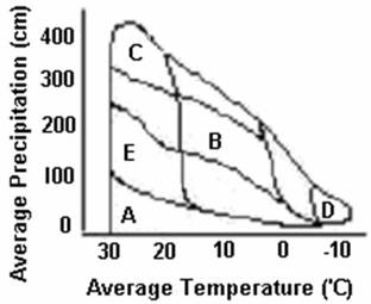A) damage by off-road vehicles.
B) air pollution.
C) conversion to farmland.
D) global climate change.
E) mineral extraction.
G) A) and E)
Correct Answer

verified
Correct Answer
verified
Multiple Choice
What is unique about the Mediterranean climate area biome?
A) It is a highly desirable place to live.
B) It is only found in the Mediterranean area.
C) It has very poor soil but supports an extremely diverse array of species.
D) It has a large total area.
E) It contains a high number of unique species.
G) B) and D)
Correct Answer

verified
Correct Answer
verified
Multiple Choice
The location of specific biomes can be predicted based on
A) the Coriolis Effect.
B) the Second Law of Thermodynamics.
C) precipitation and temperature.
D) seasonal variations in sunspots.
E) large landforms in the area.
G) A) and B)
Correct Answer

verified
Correct Answer
verified
Multiple Choice
Which of the following is true?
A) Humans may have been causing extinctions thousands of years ago, but our impact has recently increased.
B) Humans are responsible for many of the mass extinctions in the geologic record.
C) Humans only began causing extinctions in the past 150 years.
D) Humans have never had significant impact on species extinctions until the past four decades.
E) Humans have been causing extinctions for thousands of years and we are still causing extinctions at about the same rate.
G) A) and B)
Correct Answer

verified
Correct Answer
verified
True/False
Tropical moist forests have high species diversity because they have highly developed, diverse niche opportunities and habitats.
B) False
Correct Answer

verified
Correct Answer
verified
Multiple Choice
Use the following graph to answer the question.
 -The area marked "A" has a
-The area marked "A" has a
A) wide precipitation range and narrow temperature range.
B) narrow precipitation and temperature range.
C) wide precipitation and temperature range.
D) wide temperature range and narrow precipitation range.
E) varying temperature and narrow precipitation range.
G) A) and D)
Correct Answer

verified
Correct Answer
verified
Multiple Choice
The primary difference between a bog and a fen is
A) fens are fed by groundwater, bogs are fed by rainfall.
B) fens have many trees, bogs have none.
C) fens are always on the coast, bogs are inland.
D) bogs are found only in brackish areas.
E) There are no differences between fens and bogs, they are synonymous.
G) B) and E)
Correct Answer

verified
Correct Answer
verified
Multiple Choice
The objective of a species recovery plan is to
A) interbreed threatened species with common species.
B) increase an endangered species population until it is no longer endangered.
C) invest corporate capital in species maintenance.
D) study the species for a better understanding of its role in the biological community.
E) protect the species to aid other organisms and resources in the ecosystem.
G) B) and E)
Correct Answer

verified
Correct Answer
verified
Multiple Choice
The main reason that there are relatively few invertebrates categorized as endangered species is because
A) we consider other groups, such as mammals, to be more interesting and desirable.
B) worldwide there are relatively few invertebrates when compared to plants.
C) it is extremely difficult to identify and count invertebrates.
D) Since there are 532 invertebrates considered endangered, none of these are true.
E) invertebrates are more numerous and the relative percentages are similar.
G) B) and C)
Correct Answer

verified
Correct Answer
verified
True/False
Estuaries contain a mix of fresh and salt water.
B) False
Correct Answer

verified
Correct Answer
verified
Multiple Choice
Ecological diversity is a measure of the number of
A) different kinds of organisms within a community or ecosystem.
B) different versions of the same gene in an ecological community.
C) sizes, colors, and shapes of organisms within an ecological community.
D) niches, trophic levels, and ecological processes of a biological community.
E) different species in an ecosystem.
G) C) and D)
Correct Answer

verified
Correct Answer
verified
True/False
Estuaries are often referred to as nursery areas due to the number of organisms that use them for breeding.
B) False
Correct Answer

verified
Correct Answer
verified
Multiple Choice
The biome that is most at risk due to over-harvest of organisms might be the
A) marine biome.
B) tropical rainforest biome.
C) tundra biome.
D) desert biome.
F) A) and D)
Correct Answer

verified
Correct Answer
verified
Multiple Choice
One biome type that has not been as badly threatened as other biomes is
A) arctic tundra.
B) tropical rainforests.
C) grasslands.
D) temperate forests.
E) southern pine forests.
G) C) and E)
Correct Answer

verified
Correct Answer
verified
Multiple Choice
Most of the species that are yet undiscovered are probably
A) mammals and reptiles.
B) birds and fish.
C) fungi.
D) invertebrates.
E) multicellular plants.
G) A) and C)
Correct Answer

verified
Correct Answer
verified
Multiple Choice
In general, funding for recovery programs is given to species that are
A) in the most danger.
B) the most important.
C) most well known.
D) most numerous.
E) keystone species.
G) B) and E)
Correct Answer

verified
Correct Answer
verified
Showing 21 - 36 of 36
Related Exams